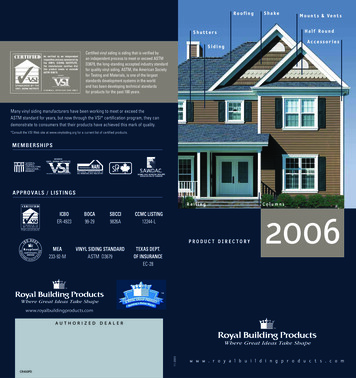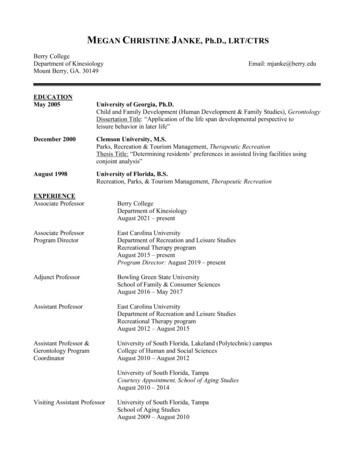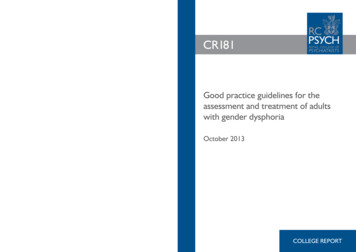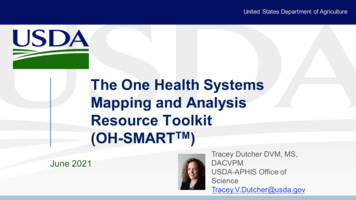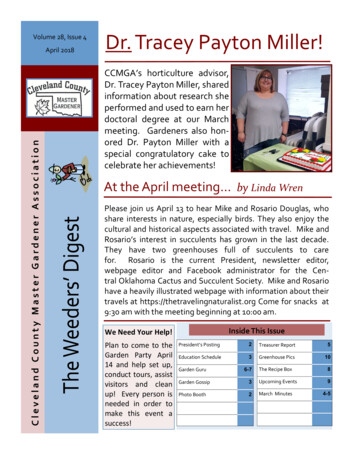
Transcription
Searches forat the LHCDr Tracey BerryRoyal HollowayUniversity of LondonTracey BerrySeminar, SouthamptonMay 20081
Overview Theoretical Motivations Extra Dimensional Models Considered Signatures Covered Search Facilities: ATLAS & CMS Present Constraints and Discovery Limits for ED(ADD, RS, TeV-1) Uncertainties Summary of LHC Start-up Expectations ConclusionsTracey BerrySeminar, SouthamptonMay 20082
Extra Dimensions: MotivationsIn the late 90’s Large Extra Dimensions (LED) were proposed as asolution to the hierarchy problem MEW (1 TeV) MPlanck (1019 GeV)?Randall, Sundrum,Arkani-Hamed, Dimopoulos, Dvali,Phys Lett B429 (98)Many (δ) large compactified EDsIn which G can propagateMPl 2RδMPhys Rev Lett 83 (99)1 highly curved EDGravity localised in the EDPlanckTeV brane(2 δ)Pl(4 δ)Λπ Mple-kRcπEffective MPl 1TeV ifcompact space (Rδ) is largeΛπ TeVif warp factor kRc 11-12Since then, new Extra Dimensional models have been developedand been used to solved other problems:Dark Matter, Dark Energy, SUSY Breaking, etcSome of these models can be/have been experimentally tested athigh energy collidersTracey BerrySeminar, SouthamptonMay 20083
Extra dimensions? “String theories” predict that there are actually 10 or 11dimensions of space-time The “extra” dimensions may be too small to bedetectable at energies less than 1019 GeV– To a tightrope walker, the tightrope is onedimensional: he can only move forward or backwardTracey BerrySeminar, SouthamptonMay 20084
Extra Dimensions More than the 3 space 1 time dimensions we experience The “extra” dimensions could be hidden to us:– E.g. they are small that only extremely energetic particlescould fit into them(so we need high energies to probe them)– Or only some kinds of matter are able to move in the extradimensions, and we are confined to our world.like something that was forced toreside on the surface of a tabletop,being unaware of any such thing asup or down.Tracey BerrySeminar, SouthamptonMay 20085
Extra Dimensional ModelsArkani-Hamed, Dimopoulos, Dvali,GPhys Lett B429 (98)(Many) Large flat Extra-Dimensions (LED) could be as large as a few µmIn which G can propagate, SM particles restricted to 3D braneRandall, Sundrum,PlanckPhys Rev Lett 83 (99)bTeV braneSmall highly curved extra spatial dimension(RS1 – two branes) Gravity localised in the ED-1sized EDsDienes, Dudas, Gherghetta,Nucl Phys B537 (99)SM chiralfermionsSM GaugeBosonsW, Z, γ, gBosons could also propagate in the bulkFermions are localized at the same (opposite) orbifold point: destructive(constructive) interference between SM gauge bosons and KK excitationsNot covered here!All SM particles propagate in “Universal” EDoften embedded in large EDTracey BerrySeminar, SouthamptonMay 2008W, Ze, µG6
Main phenomenologies under study at the LHC Large Extra Dimensions (ADD): only gravity in the bulk KK Graviton Direct Production Missing ET signature KK Graviton Exchange Drell-Yan Randall-Sundrum Model KK Graviton TeV resonances Radion Higgs-like signature TeV-1 Extra Dimensions: also gauge fields in the bulk KK gauge bosons multi-TeV resonances Different αs running Universal Extra Dimensions: all SM fields in the bulk Through radiative corrections, spectrum of KK resonance: SUSYlike phenomenology Semi-stable KK resonances of quarks Black-Hole productionTracey BerrySeminar, SouthamptonMay 20087
Experimental Signatures ofCovered in this talk Single jets/Single photons missing ET(direct graviton production in ADD) Di-lepton, di-jet continuum modifications(virtual graviton production in ADD) Di-lepton, di-jet and di-photon resonances(new particles) in RS1-model (RS1-graviton) andTeV-1 ED model (ZKK)EmissionADDExchange (Single leptons missing ETin TeV-1 ED model (WKK) bŠ tŧ resonancesin TeV-1 ED model)Tracey BerryADD RS TeV-1Seminar, SouthamptonMay 20088
Present/Past ED Search FacilitiesTevatron, Fermilab, USALEP, CERN, GenevaCERN: world'slargest particlephysics laboratoryCDFpe- e D0Tevatron: Highestenergy collideroperating in the world!Run I s 1.8 TeVRun II s 1.96 TeVTracey BerryLEP I s 91 GeVLEP II s 136-208 GeVSeminar, SouthamptonMay 20089
Future ED Search Facilities!Bigger Collider & Detectors!!LHC: proton – proton collisionsHigher center of mass energy s 14 TeVTracey BerrySeminar, SouthamptonMay 200810
Large Hadron Collider27 km ringprotonsTracey BerrySeminar, SouthamptonMay 2008protons11
Large Hadron ColliderThe is LHC the world’s largest particle acceleratorIt accelerates protons to 99.9999991 % of the speed of light!A chain of accelerators to reach the required energyProtons circle the 27km ring 11000 times per second!Tracey BerrySeminar, SouthamptonMay 200812
The Large Hadron ColliderInside the tunnel at the Large Hadron ColliderTracey BerrySeminar, SouthamptonMay 200813
LHC Magnets9300 magnets inside the ringThe LHC is kept at a super cool by the'cryogenic distribution system', whichcirculates superfluid helium around theaccelerator ring.It is at temperature of -271.3 C (1.9 K)– even colder than outer space!Just one-eighth of its cryogenic distribution systemSouthamptonwouldworld’slargest fridge!TraceyBerryqualify as theSeminar,May 200814
Collisionsprotonsprotons7 TeV(Tera-electronvolt)7 TeVhead-to-head collisions energy 14 TeV7 times the energy of any previous acceleratorThe collision generate temperatures more than100 000 times hotter than the heart of the Sun!600 million collisions per secondTracey BerrySeminar, SouthamptonMay 200815
DetectorsATLASCMSTracey BerrySeminar, SouthamptonMay 200816
ATLAS and CMS ExperimentsLarge general-purpose particle physics detectorsA Toroidal LHC ApparatuSCompact Muon SolenoidTotal weightOverall diameterBarrel toroid lengthEnd-cap end-wall chamber spanMagnetic field7000 t25 m26 m46 m2 TeslaTotal weightOverall diameterOverall lengthMagnetic field12 500 t15.00 m21.6 m4 TeslaDetector subsystems are designed to measure:energy and momentum of γ ,e, µ, jets, missing ET up to a few TeVTracey BerrySeminar, SouthamptonMay 200817
ATLASTracey Berry(A Toroidal LHC ApparatuS)Seminar, SouthamptonMay 200818
ATLASLargest volume particle detector ever constructed!Overalldiameter25 mlong 46 mATLAS is half the size ofNotre Dame CathedralTracey BerrySeminar, SouthamptonMay 200819
Detectors6 storeyshighTracey BerrySeminar, SouthamptonMay 200820
ATLASTotal weight: 7000 tonnes 100 jets (empty)Tracey BerrySeminar, SouthamptonMay 200821
DataIn 1 year ATLAS will record 3200 Terabytes of dataequivalent to: 7 km of stacked up CDROMs !Soundingballon(30 km)1 yearLHC data( 20 km)Concorde(15 km)Mont-Blanc(4.8km)Tracey BerrySeminar, SouthamptonMay 20081 yearATLASdata!(7km)22
The Computing Challenge100,000 PCs needed to analyse it!distributed computing networkcalledtheTracey BerryGridSeminar, SouthamptonMay 200823
ModelArkani-Hamed, Dimopoulos, Dvali,Phys Lett B429 (98), Nuc.Phys.B544(1999)(Many) Large flat Extra-Dimensions (LED),could be as large as a few µmGG can propagate in EDSM particles restricted to 3D braneThe fundamental scale is not planckian: MD MPl(4 δ) TeVModel parameters are:MPl2 RδMPl(4 δ)(2 δ) δ number of ED MPl(4 δ) Planck mass in the 4 δ dimensionsFor MPl 1019 GeV and MPl(4 δ) MEW R 1032/δ x10-17 cmTracey BerrySeminar, SouthamptonMay 200824
Present Constraints on theModelMPl2 RδMPl(4 δ)(2 δ)GFor MPl 1019 GeV and MPl(4 δ) MEW R 1032/δ x10-17 cm δ 1 R 1013 cm, ruled out becausedeviations from NewtonianRun Igravity over solar distances have not been observed δ 2 R 1 mm, not likely because of cosmological arguments:In particular graviton emission from Supernova 1987a* implies MD 50 TeVClosest allowed MPl(4 n) value for δ 2 is 30 TeV, out of reach at LHCCan detect at collider detectors via: graviton emission Or graviton exchange*Cullen, PerelsteinPhys. Rev. Lett 83,268 (1999)Tracey BerrySeminar, SouthamptonMay 200825
ADD Collider Signatures Real Graviton emission in association with a vector-bosonSignature: jets missing ET, V missing ETσ depends on the number of EDGg,qg, jet,VGJets missing ET, γ missing ET Virtual Graviton exchangeSignature:deviations in σ and asymmetries of SM processese.g. q l l-, γ γ & new processes e.g. gg l lqq l l Tracey Berrygg l l g,qg, f,V ,VBroad increase in σRunduetoI closelyspaced summedover KK towersExcess abovedi-lepton continuumSeminar, SouthamptonMay 2008CDF Run Iλ 126 Mll
Present ADD Emission LimitsLEP and Tevatron results are complementaryqqFor n 4: LEP limits best γ METTracey BerrySeminar, SouthamptonMay 2008gGkkgggGkkFor n 4: CDF combinedlimits best27
Tevatron ADD Exchange LimitsBoth D0 and CDF have observed no significant excess95% CL lower limits on fundamental Planck scale (Ms) inTeV, using different formalisms:most stringentcollider limits onLED to date!GRWGRW23D0 Run II: µµD0 Run II: ee γγD0 Run I II: ee γγ1.091.0021.2931.0941.361.561.611.431.61CDF Run II: ee200pb-1 1.11HLZ for n Hewett67Hewettλ 1/-10.9850.9160.8670.97/0.95λ .28/NA1.321.111.000.930.88 0.96/0.994HLZ for n 5D0 perform a 2D search in invariant mass & angular distributionAnd to maximise reconstruction efficiency they perform combined ee γγ(diEM) search: reduces inefficiencies fromγe γ ID requires no track, but γ converts ( ee)e e ID requires a track, but loose track due to imperfect trackreconstruction/crackTracey BerrySeminar, SouthamptonMay 200828
Present Constraints on theModelMPl2 RδMPl(4 δ)(2 δ)GFor MPl 1019 GeV and MPl(4 δ) MEW R 1032/δ x10-17 cm δ 1 R 1013 cm, ruled out becausedeviations from NewtonianRun Igravity over solar distances have not been observed δ 2 R 1 mm, not likely because of cosmological arguments:In particular graviton emission from Supernova 1987a* implies MD 50 TeVClosest allowed MPl(4 n) value for δ 2 is 30 TeV, out of reach at LHC LEP & Tevatron limits is MPl(4 δ) 1TeV δ 6 difficult to probe at LHC since cross-sections are very low*Cullen, PerelsteinPhys. Rev. Lett 83,268 (1999)Tracey BerrySeminar, SouthamptonMay 200829
ADD Discovery Limit: γ G EmissionReal graviton productionpp γ GKKJ. Weng et al. CMS NOTE 2006/129 γG high-pT photon high missing ETAt low pT the bkgd, particularlyIntegrated Lum for a 5σ significance discoveryirreducible Ζγ ννγ is toolarge require pT 400 GeV Main Bkgd: Zγ ννγ,Also W e(µ,τ)ν, Wγ eν,γ jets, QCD, di-γ, Z0 jets Signals generated with PYTHIA(compared to SHERPA)Bkgds: PYTHIA and compared toSHERPA/CompHEP/Madgraph (B)Using CTEQ6L Full simulation & reconstruction Theoretical uncert.Significance: S 2( (S B)- B) 5MD 1– 1.5 TeV for 1 fb-12 - 2.5 TeV for 10 fb-13 - 3.5 TeV for 60 fb-1Not considered by CMS analysis: Cosmic Rays at rate of 11 HZ: mainbackground at CDF, also beam halo muons for pT 400 GeV rate 1 HZTracey BerrySeminar, SouthamptonMay 200830
ADD Discovery Limit: γ G EmissionATLASL.Vacavant, I.HinchcliffeATLAS-PHYS 2000-016J. Phys., G 27 (2001) 1839-50pp γ GKK : q γGKKRates for MD 4TeV are very lowMDMAX (TeV)δ 2HL 100fb-1 4For δ 2: No region where the modelindependent predictions can bemade and where the rate is highenough to observe signal eventsover the background.This gets worse as δ increases Better limits from the jet G emission which has a higher production rateThis signature could be used as confirmation after the discovery in thejet channelsTracey BerrySeminar, SouthamptonMay 200831
ADD Discovery Limit: jet G EmissionReal graviton productionpp jet GKKgg gG, qg qG & q GgDominant subprocess Signature: jet G jet with high transverseenergy (ET 500 GeV) high missing ET(ETmiss 500 GeV), vetos leptons: to reduce jet W bkdg mainly Bkgd.: irreducible jet Z/W jet νν /jet lνjZ(νν) dominant bkgd, can be calibratedusing ee and µµ decays of Z.Discovery limits ISAJET with CTEQ3LMPl(4 d)MAX(TeV) δ 2 Fast simulation/recoTracey Berryδ 3δ 4LL 30fb-17.76.25.2HL 100fb-19.17.06.0Seminar, SouthamptonMay 2008L.Vacavant, I.Hinchcliffe, ATLAS-PHYS 2000-016J. Phys., G 27 (2001) 1839-5032
ADD Parameters: jet G EmissionTo characterise the model need to measure MD and δMeasuring σ(pp jet GKK) gives ambiguous resultsUse variation of σ on sσ at different s almostindependent of MD,varies with δRun at two different se.g. 10 TeV and 14 TeV, need 50 fb-1Rates at 14 TeV of δ 2 MD 6 TeV verysimilar to δ 3 MD 5 TeV whereasRates at 10 TeV of (δ 2 MD 6 TeV) and(δ 3 MD 5 TeV) differ by factor of 2Tracey BerrySeminar, Southampton33L.Vacavant, I.Hinchcliffe, ATLAS-PHYS 2000-016May 2008J. Phys., G 27 (2001) 1839-50
ADD Discovery Limit: G ExchangeVirtual graviton productionpp GKK µµ Two opposite sign muons in thefinal state with Mµµ 1 TeV Irreducible background from DrellYan, also ZZ, WW, WW, tt(suppressed after selection cuts) PYTHIA with ISR/FSR CTEQ6L,LO K 1.38 Full (GEANT-4) simulation/reco L1 HLT(riger) Theoretical uncert. µ and tracker misalignment, triggerand off-line recon. inefficiency,acceptance due to PDFTracey BerryConfidence limits for1 fb-1:10 fb-1:100 fb-1:300 fb-1:Seminar, SouthamptonMay 20083.9-5.5 ТеV for n 6.34.8-7.2 ТеV for n 6.35.7-8.3 ТеV for n 6.35.9-8.8 ТеV for n 6.3Belotelov et al.,34CMS NOTE 2006/076, CMS PTDR 2006
ADD Discovery Limit: G ExchangeVirtual graviton productionCMS Confidence limits:V. Kabachenko et al.ATL-PHYS-2001-012Tracey BerryFast MC1 fb-1:10 fb-1:100 fb-1:300 fb-1:Seminar, SouthamptonMay 20083.9-5.5 ТеV for n 6.34.8-7.2 ТеV for n 6.35.7-8.3 ТеV for n 6.35.9-8.8 ТеV for n 6.3Belotelov et al.,35CMS NOTE 2006/076, CMS PTDR 2006
ADD Discovery Limits SummaryCan use LHC to search for ADD ED with δ 6δ 2 ruled outMD 1TeV from TevatronPhoton Met CMSDiscovery above 3.5 TeV notpossible in this channelMD 1– 1.5 TeV for 1 fb-12 - 2.5 TeV for 10 fb-13 - 3.5 TeV for 60 fb-1CMS Exchange limits:1 fb-1:10 fb-1:100 fb-1:300 fb-1:3.9-5.5 ТеV for n 6.34.8-7.2 ТеV for n 6.35.7-8.3 ТеV for n 6.35.9-8.8 ТеV for n 6.3Tracey BerryJet Met ATLASMPl(4 d)MAX(TeV)δ 2δ 3δ 4LL 30fb-17.76.25.2HL 100fb-19.17.06.0ATLAS Exchange LimitsSeminar, SouthamptonMay 200836
10–6HDilepton channelTevatron 700 GeV GKKExperimental Signature for10-81 extra warpeddimensionSignature:Narrow, high-mass resonance statesin dilepton/dijet/diboson channelsqq , gg GKK e e , µ µ ,γγ , jet jet ModelModel parameters:Λπ Mple-kRcπ Gravity Scale:Resonancest1 graviton excitation mass: m1 positionΛπ m1Mpl/kx1, & mn kxnekrcπ(J1(xn) 0) Coupling constant: c k/MPlΓ1 ρm1 x12 (k/Mpl)2 widthk curvature, R compactification radius400 600 800 1000K/MPlMll (GeV)dσ/dM 10-2KK excitationscan beexcitedindividuallyon(pb/GeV)700 -4GeV KK Graviton at theresonance10Tevatron1-6 1,0.7,0.5,0.3,0.2,0.1 fromk/M0.510PlLHCtop tobottom0.1-810 1500 GeV GKK0.05and subsequent tower states10-100.011000Tracey BerrySeminar, SouthamptonMay 200830005000Mll (GeV)Davoudiasl, Hewett, Rizzohep-ph000604137
Present RS ConstraintsD0 performed combinedee γγ (diem search)CDF performed ee & γγ search, then combinePresent Experimental LimitsTheoretical Constraints c 0.1 disfavoured as bulk curvaturebecomes to large (larger than the 5dim Planck scale)Tracey Berry Theoretically preferred Λπ 10TeVassures no new hierarchy appearsbetween mEW and ΛπSeminar, SouthamptonMay 200838
RS1 Discovery LimitHewett, Rizzo400 600 Davoudiasl,800 1000hep-ph0006041At the LHC only the 1st excitations arelikely to be seen at the LHC, since theother modes are suppressed by thefalling parton distribution functions.Allenach et al, JHEP 9 19 (2000), JHEP 0212 39 (2002) K/MPlM(GeV)dσ/dMKKllexcitations can beexcitedindividually on(pb/GeV)700 -4GeV KK Gravitonat theresonance10Tevatron1-6 1,0.7,0.5,0.3,0.2,0.1 fromk/M0.510PlLHCtop tobottom0.110-8 1500 GeV GKK0.05and subsequent tower states10-100.0110-2Best channels to search in are G(1) e e- andG(1) γγ due to the energy and angular resolutionsof the LHC detectorsG(1) e e- best chance of discovery due torelatively small bkdg, from Drell-Yan*Allenach et al, hep-ph0006114Tracey Berry100030005000Mll (GeV)*Allenach et al, hep-ph0211205Seminar, SouthamptonMay 200839
RS1 Discovery LimitDi-electron100 fb-1MG 1.5 TeV HERWIG Main Bkdg: Drell-Yan Model-independent analysis RS model with k/MPl 0.01 as a reference(pessimisitc scenario) Fast Simulation*Reachgoes up to 3.5 TeV for c 0.1 fora 20% measurement of the coupling.Allenach et al, hep-ph0006114Tracey BerrySensitive at 5σ up to 2080 GeV*Allenach et al, hep-ph0211205Seminar, SouthamptonMay 200840
RS1 Discovery LimitDi-lepton statesI. Belotelov et al.CMS NOTE 2006/104CMS PTDR 2006c 0.01100 fb-1c 0.1100 fb-1G1 µ µSolid lines 5σ discoveryDashed 1σ uncert. on L Two muons/electrons in the final state Bckg: Drell-Yan/ZZ/WW/ZW/ttbar PYTHIA/CTEQ6L LO K 1.30 both for signal and DY Full (GEANT-4) and fast simulation/reco Viable L1 HLT(rigger) cuts Theoretical uncert.B. Clerbaux et al.CMS NOTE 2006/083CMS PTDR 2006 Misalignment, trigger and off-line recoinefficiency, pile-upSeminar, SouthamptonTracey BerryMay 2008G1 e e-41
RS1 Discovery LimitDi-photon states Two photons in the final stateG1 γγ Bckg: prompt di-photons, QCD hadronic jetsand gamma jet events, Drell-Yan e e PYTHIA/CTEQ5L LO for signal, LO K-factors for bckg. Fast simulation/reco a few points withfull GEANT-4 MCM.-C. Lemaire et al. Viable L1 HLT(rigger) cutsCMS NOTE 2006/051CMS PTDR 2006 Theoretical uncert.c 0.1 Preselection inefficiencyDi-jet states Bckg: QCD hadronic jets L1 HLT(rigger) cutsK. Gumus et al.CMS NOTE 2006/070CMS PTDR 20065σ Discovered Mass: 0.7-0.8 TeV/c2Tracey BerrySeminar, SouthamptonMay 200842
CMS RS Discovery LimitsG1 µ µ-G1 γγc 0.1 disfavoured asbulk curvaturebecomes to large(larger than the 5-dimPlanck scale)Theoretically preferredΛπ 10TeVG1 e e-LHC completely coversthe region of interestTracey BerrySeminar, SouthamptonMay 200843
RS1 Model ParametersA resonance could be seen in many other channels: µµ, γγ, jj, bbbar,ttbar, WW, ZZ, hence allowing to check universality of its couplings:Relative precision achievable (in %) for measurementsof σ.B in each channel for fixed points in the MG,Λπplane. Points with errors above 100% are not shown.Also the size (R) of the ED could also be estimated from mass and crosssection measurements.Allenach et al, hep-ph0211205Allenach et al, JHEP 9 19 (2000), JHEP 0212 39 (2002)Tracey BerrySeminar, SouthamptonMay 200844
RS1 Model DeterminationHow could a RS G resonance be distinguished from a Z’ resonance?Potentially using Spin information:G has spin 2: pp G ee has 2 components: gg G ee &q G ee: each with different angular distributions:MG 1.5 TeV e eMC 1001.5 fbTeV-1LHCSpin-2 could be determined (spin-1 ruled out) with 90% C.L.up to MG 1720 GeV with 100 fb-1Note: acceptance at large pseudo-rapidities is essential for spindiscrimination (1.5 eta 2.5)Tracey BerrySeminar, SouthamptonMay 2008Allanach et al, hep-ph 000611445
TeV-1 Extra Dimension ModelI. Antoniadis, PLB246 377 (1990) Multi-dimensional space with orbifolding(5D in the simplest case, n 1) The fundamental scale is not planckian:MD TeV Gauge bosons can travel in the bulk Search for KK excitations of Z,γ.New ParametersR MC-1 : size of the compactdimensionMC : correspondingcompactification scaleM0 : mass of the SM gauge bosonCharacteristic Signature: KK excitations of the gaugebosons appearing as resonances with masses :Mn (M02 n2/R2) where (n 1,2, ) & alsointerference effects!pp Z1KK/γ1G. Azuelos, G. PoleselloEPJ Direct 10.1140 (2004)KK e e- Fundamental fermions (quarks/leptons) can belocalized at the same (M1) oropposite (M2) points of orbifold destructive (M1) or constructive (M2)interference of the KK excitationswith SM model gauge bosonsTracey BerrySeminar, SouthamptonMay 2008me e- (GeV)M n M046
Present Constraints on TeV-1 EDD0 performed the first dedicated experimental search for TeV-1 ED at a colliderSearch for effects of virtual exchanges of the KK states of the Z and γSearch Signature: Signal has 2 distinct features: enhancement at large masses (like LED) negative interference between the 1st KK state of the Z/γ and the SMDrell-Yan in between the Z mass and MCBetter Limit: from precisionelectroweak data MC 4 GeVWorld Combined Limit MC 6.8 TeVat 95% C.L, dominated by LEP2measurementsTracey BerrydiEM Mass Spectrum410Events/10 GeVdiEM search 200 pb-1Lower limit on the compactificationscale of the longitudinal ED:MC 1.12 TeV at 95% C.L.DØ Run II Preliminarypredictedbackground310210L 200pb-1SM Drell-Yan101TeV-1 ED signalηc 5.0 TeV-2-11010-2-3100Seminar, SouthamptonMay 20081002003004005006007008009001000diEM Mass, GeV47
TeV-1 ED Discovery LimitsATLAS expectations for e and µ:2 leptons with Pt 20GeV in η 2.5, mll 1TeVReducible backgrounds from tŧ, WW, WZ, ZZPYTHIA Fast simu/paramaterized reco Theor. uncert.γ(1)/Z(1) e e-/µµ µ-Worseresolutionfor µIn ee channelexperimentalresolution is smallerthan the naturalwidth of the Z(1) , inµµ channel exp.momentum resol.dominates the width2 TeV e in ATLFAST: E/E 0.7 % 20% for µEven for lowest resonances of MC (4 TeV), no events would be observed forthe n 2 resonances of Z and γ at 8 TeV (Mn (M02 n2/R2)), whichwould have been the most striking signature for this kind of model.Tracey BerrySeminar, SouthamptonMay 2008G. Azuelos, G. PoleselloEPJ Direct 10.1140 (2004)G. Azuelos, G. Polesello (Les Houches 2001 Workshop Proceedings), Physics at TeV Colliders, 210-228 (2001)48
TeV-1 ED Discovery Limitsγ(1)/Z(1) e e-/µµ µ-Several Methods have been used to determine the discovery limitsfor this signature: model independent & dependent1) Model independent search for the resonance peak– lower mass limit2) 2 sided search window – search for the interference3) Model dependent – fit to kinematics of signalEvent kinematics* can be fullydefined by the 3 variablesx1PAx2PBTracey BerrySeminar, SouthamptonMay 2008G. Azuelos, G. PoleselloEPJ Direct 10.1140 (2004)49
Method 1: Lower Mass Limit Model IndependentSimple number counting technique.Naïve reach estimate for the observation of anincrease in the mll distributionChoice of lower boundFor each different MC value:lower bound on mll is different:chosen such to keep as much aspossible of the resonance widthNumber of events expected inMC mass of-1lowest lying the peak for L 100 fbSignal BkdgKK excitation MlllowerArbitrary requirement for discovery:require 10 events to be detectedabove mll summed over the leptonflavours, and a statistical significanceS (N-NB)/ NB 5Tracey BerryFor 100 fb-1 using this method, the reach isMC (R-1) 5.8 TeV (ee µµ)Seminar, SouthamptonMay 200850
Method 2: Mass Window1st approach to study the off-peak region: Evaluate NS and NB within a mass range –compare to w.r.t SMe e- 100 fb-1 in mass window1000 mee 2000 GeV For ee µµ channels, the ATLAS 5σ reach is 8 TeV for L 100 fb-1 and 10.5 TeV for 300 fb-1Better limit than the MC (R-1) 5.8 TeV (ee µµ) for 100 fb-1 using lower boundmethod 1 to search for the resonanceSeminar, Southampton51Tracey BerryMay 2008
Method 3: Optimal Reach andMass Measurement Model DependentUse the full information in the events, not just mllγ(1)/Z(1) e e-/µµ µ-Event kinematics* are fully defined by the 3variablesAn optimal measurement of MC can be obtainedby a likelihood fit to the reconstructeddistributions for these 3 variables.With 300 fb-1 can reach 13.5 TeV (ee µµ)Tracey BerrySeminar, SouthamptonMay 200852
TeV-1 ED Discovery LimitsDi-electron states (ZKK decays) Two high pT isolated electronsin the final state5σσ discovery limit ofpp Z1KK/γ1KK e e- Bckg: irreducible: Drell-YanAlso ZZ/WW/ZW/ttabr(M1 model) Signal and Bkgd: PYTHIA,CTEQ61M, PHOTOS used for innerbremsstrahlung production LO K 1.30 for signals,LO K-factors for bckg. Full (GEANT-4) simulation/recowith pile-up at low lum. ( 1033cm-2s-1) L1 HLTrigger cuts Theoretical uncert.Tracey BerryWith L 30/80 fb-1 CMS will be ableto detect a peak in the e e- invar.mass distribution if MC 5.5/6 TeV.Seminar, SouthamptonMay 2008B. Clerbaux et al.CMS NOTE 2006/083CMS PTDR 2006b53
Model DiscriminationHow could a 4 TeV Z (1)/γ(1) resonance be distinguished from a 4 TeV Z’ orRandall-Sundrum Model Graviton ?4 TeV resonancesZ(1) or Z’ or RS Graviton?ATLASLook at the angular distributionsof the decay productsNote: Z and Z(1) : spin-1G : spin-2Mass distributions are normalized to aluminosity of 100 fb-1Tracey BerrySeminar, SouthamptonMay 2008G. Azuelos, G. Polesello 54EPJ Direct 10.1140 (2004)
Distinguishing Z(1) from Z’, RS GSelect events around the peak of theresonance 3750 GeV Mee 4250 GeVPlot cosine of the angle of the lepton,w.r.t the beam direction, the frame ofthe decaying resonance.Angular distributions are normalized to 116events, the number predicted with aluminosity of 100 fb-1 for the Z(1)/γ(1) caseSeminar, Southampton55( ve direction was defined by the sign of reconstructedmomentum in the dilepton system.)Tracey BerryMay 2008G. Azuelos, G. Polesello EPJ Direct 10.1140 (2004)
Distinguishing Z(1) from Z’, RS G Spin 1 Z(1) signal can be distinguished from a spin-2 narrow graviton resonanceusing the angular distribution of its decay products. Z(1) can also be distinguished from a Z’ with SM-like couplings using thedistribution of the forward-backward asymmetry: due to contributions of thehigher lying states, the interference terms and the additional 2 factor in itscoupling to SM fermions.The Z(1) can be discriminated for masses up to about 5 TeV with L 300fb-1.Z(1) or Z’ or RS Graviton?ATLASTracey BerrySeminar, SouthamptonMay 20084 TeV resonancesG. Azuelos, G. PoleselloEPJ Direct 10.1140 (2004)G. Azuelos, G. Polesello 56EPJ Direct 10.1140 (2004)
Experimental UncertaintiesSystematic uncertainties associated with the detector measurements Luminosity Energy miscalibration which affects the performance of e/γ/hadronenergy reconstruction Drift time and drift velocities uncertainties Misalignment affects track and vertex reconstruction efficiency increase of the mass residuals by around 30% Magnetic field effects can cause a scale shift in a mass resolutionby 5-10% Pile-up mass residuals increase by around 0.1-0.2% Trigger and reconstruction acceptance uncertainties Affect the background and signal Background uncertainties: variations of the bkgd shape a drop ofabout 10-15% in the significance valuesTracey BerrySeminar, SouthamptonMay 200857
Theoretical Uncertainties QCD and EW higher-order corrections (K-factors)Parton Distribution Functions (PDF)Hard process scale (Q2)Differences between Next-to-Next-to-Leading Order (NNLO), NLOand LO calcalations affect signal and background magnitudes,efficiency of the selection cuts,significance computation Tracey BerrySeminar, SouthamptonMay 200858
PDF Impact on Sensitivity to ED Extra dimensions affect the di-jet cross section through the running of αs. So could potentially use σ deviation to detect EDParameterised by number of extra dimensions δ and compactification scale Mc.MC 2 TeVSMMC 2 TeVMC 6 TeVPDFuncertainties2XD4XD6XD PDF uncertainties (mainly due to high-x gluon) give an uncertainty “zone” onthe SM cross sections This reduces sensitivity to MC from 5 TeV to 2 (3) TeV for δ 4, 6 andfor δ 2 sensitivity is lost (MC 2 TeV)Tracey BerrySeminar, SouthamptonMay 2008Ferrag, hep-ph/040730359
LHC Start-up ExpectationsModelMass reachIntegratedLuminosity (fb-1)SystematicuncertaintiesADD Direct GKKMD 1.5-1.0 TeV, n 3-61Theor.ADD VirtualGKKMD 4.3 - 3 TeV, n 3-6MD 5 - 4 TeV, n 3-60.11Theor. Exp.di-electronsdi-photonsdi-muonsdi-jetsMG1 1.35- 3.3 TeV, c 0.01-0.1MG1 1.31- 3.47 TeV, c 0.01-0.1MG1 0.8- 2.3 TeV, c 0.01-0.1MG1 0.7- 0.8 TeV, c 0.1101010.1Theor. Exp.(only stat. fordi-jets)TeV-1 (ZKK(1))Mz1 5 TeV1Theor.RS1Tracey BerrySeminar, SouthamptonMay 200860
ConclusionsThe discovery potential of both experiments makes it possible to investigate ifextra dimensions really exist within various ED scenarios at a few TeV scale:Large Extra-Dimensions (ADD model)Randall-Sundrum (RS1)TeV-1 Extra dimension ModelReaches in different channels depend on the performance of detector systems:proper energy, momentum, angular reconstruction for high-energy leptons andjets, Et measurement, b-tagging and identification of prompt photonsNew results have been predicted with data of an integrated luminosity 1 fb-1Tracey BerrySeminar, SouthamptonMay 200861
The End!Backup slides Tracey BerrySeminar, SouthamptonMay 200862
RunCoordinationOperations: recent testsand planning Running scheduleRecent highlightsShifts and trainingControl Room layoutRunning efficiency Tracey BerryT.WenglerAtlasWeek07-Apr08MessagesTransition timingSeminar, SouthamptonMay 200863
Schedule: March – AprilMonthAprilDateSystemRequirements,remarksWeek 1324/3 30/3L1Calo CTP 3 daysStarting work withCalos when readyWeek 1431/3 - 6/4Calos L1Cal HLT 1weekWeek 157/4 - 13/4Week 1614/4 20/4ParallelShiftsstart testing tdaq-0109Muons 11/4 (WE?)Available forsystems CTPtestsDecide/install newoffline release by 7/4April 7-10 Tile lasertesting unavailableMuons 14-16/4Tile 17/18Available forsystems CTPtestsID standalone testsw/o CTPNo Tile LB for 10days, EB availableWeekTDAQ/HLT weekID ROSs in use1721/4 27/4Seminar, SouthamptonTracey BerryMay 2008ID standalonetests w/o CTP;BCMintegration?64Page 64
Schedule: MayMonthDateSystemAprilWeek 1828/ - 29/4L1Calo Calo run?MayWeek 1830/4 - 4/53 days TRT 3 Days SCTSub-systems:Transition to tdaq-0109Week 195/5 – 11/52 days ID combinedrunning including PixelDAQTowards end of weekafter transition to 0109Start of magnet test HLT algosavailable12/5-18/5Calo L1calo HLT-Timing, calo DQ,debugging, high rate,algo tests- Finish with a stableweek end run?Week days: morning expertwork; evening calo centraldesks-Same as aboveWeek days: morning e
Tracey Berry Seminar, Southampton May 2008 6 Extra Dimensional Models Arkani-Hamed, Dimopoulos, Dvali, G Phys LettB429 (98) Dienes, Dudas, Gherghetta, NuclPhys B537 (99)-1 sized EDs Randall, Sundrum, Planck TeV brane Phys Rev Lett83 (99)b (Many) Large flat Extra-Dimensions (LED) could be as large as a few µm
